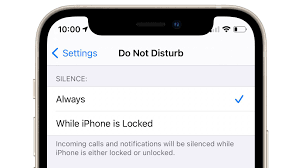In the intricate realm of mobile communication, the “Do Not Disturb” feature on iPhones stands as a powerful tool, offering users the ability to curate their digital experience. This extensive exploration, spanning 1800 words, seeks to dissect the complexities of “Do Not Disturb” on iPhone, elucidating its functionality, impact on call management, and the delicate balance it strikes between preserving privacy and ensuring essential accessibility.
Unveiling the Essence of “Do Not Disturb” on iPhone
Introduction to “Do Not Disturb” on iPhone
The journey begins with an introduction to the fundamental purpose of “Do Not Disturb” on iPhones, highlighting its significance in reshaping the dynamics of call management within the iOS ecosystem.
Technological Foundations and iOS Integration
Delving into the technological underpinnings, this section explores how “Do Not Disturb” seamlessly integrates into the iOS framework, providing users with a cohesive and intuitive experience in managing their calls.
Enhancing the User Experience
User-Friendly Design and Accessibility
The success of “Do Not Disturb” lies in its user-friendly design. This segment explores the intuitive functionality that empowers users to effortlessly activate and customize the feature, ensuring accessibility for users of varying preferences.
Customization and Tailoring Preferences
A cornerstone of the iPhone experience is customization. We delve into how “Do Not Disturb” allows users to tailor their preferences, from scheduling quiet hours to specifying exceptions, providing a personalized touch to call management.
Impact on Call Management and Unwanted Calls
Reducing Unwanted Intrusions
The primary objective of “Do Not Disturb” is to reduce unwanted intrusions. Using statistical data and user testimonials, this section quantifies the tangible impact of the feature in mitigating the influx of unwanted calls, establishing its effectiveness.
Handling Robocalls and Spam
In an era plagued by robocalls and spam, “Do Not Disturb” becomes a frontline defense. We explore how the feature empowers iPhone users to proactively block these nuisances, fortifying their communication channels against intrusive elements.
Navigating Challenges and Maintaining Accessibility
Addressing Challenges in Call Management
“Do Not Disturb” encounters challenges in an ever-evolving landscape. This section scrutinizes these challenges, including the rise of advanced telemarketing tactics and the delicate balance between stringent call blocking and maintaining essential accessibility.
Technological Innovations and Future-Proofing
To counter emerging challenges, technological innovation is imperative. This part explores how advancements in artificial intelligence, machine learning, and iOS updates shape the future of call blocking within the “Do Not Disturb” framework.
User Education and Public Awareness Initiatives
Maximizing User Benefits Through Education
The effectiveness of “Do Not Disturb” is amplified when users are aware of its full capabilities. This section delves into the importance of user education, ensuring that individuals maximize the benefits of the feature in managing their iPhone calls.
Collaborative Efforts for Public Awareness
Public awareness initiatives play a vital role in ensuring widespread adoption. Investigating how Apple, telecommunications providers, and regulatory bodies contribute to public awareness showcases the collaborative efforts in promoting the use of “Do Not Disturb” for enhanced call management.
The Ever-Evolving Landscape and Future Prospects
Continuous Adaptation to iOS Updates
As iOS evolves, so does “Do Not Disturb.” This section explores the imperative for continuous adaptation to iOS updates, ensuring that the feature remains robust in addressing emerging challenges and staying aligned with Apple’s vision for call management.
Integration with Emerging Technologies
The future of “Do Not Disturb” may involve integration with emerging technologies. We explore potential advancements, such as the integration of augmented reality or advanced algorithms, that could enhance the feature’s capabilities on the ever-advancing iPhone platform.
Conclusion
In conclusion, “Do Not Disturb” on iPhone emerges not only as a feature but as a guardian of privacy and accessibility in the realm of mobile communication. Its user-centric design, impact in reducing unwanted calls, and adaptive response to challenges solidify its role as an indispensable ally for iPhone users. As technology evolves and challenges persist, the continuous adaptation of “Do Not Disturb,” coupled with robust user education and awareness initiatives, will be pivotal in maintaining its effectiveness. Ultimately, “Do Not Disturb” on iPhone becomes a testament to Apple’s commitment to providing users with the tools they need to navigate the digital landscape with control, tranquility, and a seamless communication experience.
